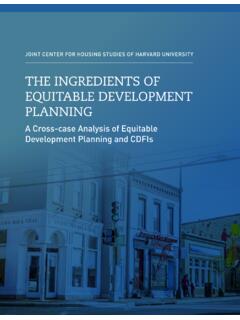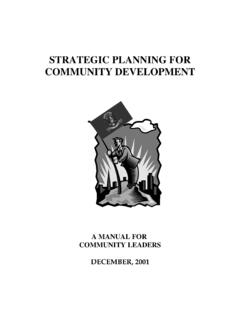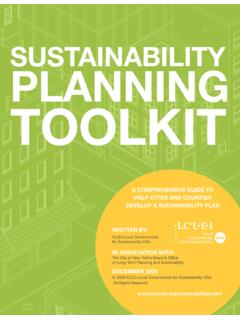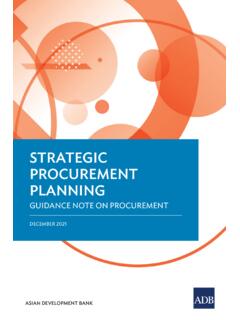Transcription of The Nigeria education system and vision 20: 2020: A ...
1 Vol. 7(2), pp. 26-38, March, 2015. DOI: Article Number: 931A19C52000 International Journal of Educational ISSN 2141-6656. Copyright 2015 Administration and Policy Studies Author(s) retain the copyright of this article Full Length Research Paper The Nigeria education system and vision 20: 2020: A. critical development planning perspective Franklins A. SANUBI1 and Nelson E. AKPOTU2*. 1. Department of Political Science, Delta State University, Abraka, Nigeria . 2. Department of Educational Administration and Policy Studies, Delta State University, Abraka, Nigeria . Received 02 June, 2014, Accepted 26 March, 2015. The study examines the call for Nigeria becoming one of the twenty most developed economies by the year 2020, as it relates to development planning in Nigeria using the educational system as a unit of analysis. It aims at examining the relevance of this call within the context of existing facilities in the Nigeria educational system both - material and human from the point of view of academic planning .
2 It adopts a historical research methodology of analysis using purely secondary data drawn from statutory documents and other sources. The study observes among other things, a worrisome disposition of the country's educational system in terms of worsening commitments of stakeholders to the maintenance and expansion of existing facilities and poor funding of this sector by the public authorities. This, the study believes has seriously imperil the country's readiness for the vision 20:2020 as education remains the bedrock of any form of national development . The study therefore suggests, among other planning strategies, an improved funding for education , and a deliberate effort at improving the status, motivation and the overall conditions of service of teachers which it is hoped, will help in reversing this ugly trend in the Nigerian educational system if the vision 20:2020 is ever to be realized. Key words: development planning , vision 20:2020, educational management, Nigeria education system , academic planning .
3 INTRODUCTION. Of the many recent national calls for improvement in the and the average GDP growth rate of 8% for the non-oil management and administration of the Nigerian state, the sector as strongly led by agriculture, Nigeria could attain vision 20:2020 stands out as one of the most topical the vision 20: 2020 if this average GDP growth rate is issues in the nation's post-independence life of well over sustained; more so as external reserves grew from 4. half a century now. The vision is a concept of national billion US Dollars in 1999 to billion US Dollars in development , which aims at moving Nigeria 's economy December, 2006. The vision seeks to ensure collateral into the league of the world's 20 largest economies by the development of Nigeria and put her economy on a fast year 2020. Among other things, it was the thinking of track to self reliance, with the main thrust of modernizing Soludo (2007) that with an average GDP growth rate of the country and raising the standard of living of the 7% recorded since 2003 as against in the 1990s people.
4 *Corresponding author. E-mail: Author agree that this article remain permanently open access under the terms of the Creative Commons Attribution License International License Sanubi and Akpotu 27. Soludo's vision emanated from the economic projec- Security; SMEs; Mining & Steel development ; Sports tions of an international investment bank - Goldman development ; Trade & Commerce; Transport; Urban &. Sachs (Soludo, 2007) which opined that if Nigeria can Regional development ; Water & Sanitation. It took nine sustain the average GDP growth rate of 8% she could months and more than 5000 Nigerians to prepare it become the 12th largest economy in the world by 2050, (Vanguard, 2012:18). Yet after being launched, the ahead of Italy, Canada, Korea, etc. This formed the basis greatest challenge ahead, which has remained unresolv- for the vision statement, for which Soludo (2007) believes ed over the years, is that of implementation as the federal the Nigerian economy has the capacity to sustain over government continues to sit on the report of that 10% growth rate in GDP in the medium term, thereby magnitude which it commissioned.
5 The vision 20:2020. becoming the China of Africa , and achieve vision 20: which in many respects coheres with the United Nations'. 2020. It is based on the premise that Nigeria has enough Millennium development Goals (MDGs) has, like the economic reserves to sustain high growth, with a huge latter, suffered serious reverses in terms of non- untapped arable land for agriculture (60 percent still implementation. Global progress reports on the MDGs as uncultivated) and the availability of huge deepwater oil at 2011 point to Nigeria as lagging behind in all the eight reserves. It is believed that, all things being equal, goals and is not likely to achieve any by the target date of Nigeria 's vast and largely youthful population can be a 2015, more so that the recent global economic recession major source of labour supply, together with the about 17 makes it elusive. million Nigerians in the Diaspora whose foreign income As the decision year for the MDGs, 2015 is reached remittances and potential supply of skills will help to and the evidence on ground reflects only a marginal, if sustain the growth rate, and provide for poverty reduc- any, picture of advancement in the envisioned MDG.
6 Tion, employment creation and the diversification of the sectors, fears and pessimism about the vision 20:2020. economy away from primary sector and dependence on have become more realistic than hope. With less than oil. half a decade to the magical year 2020, the call for Indeed, the vision 20:2020 envisages a prosperous Nigeria 's enlistment into the league of the world's twenty Nigeria that is capable of breaking away from its current most developed economies resonates more sharply in status of a natural resource, rent-dependent and academic discourses as another potential scheme of infrastructural deficient state through hard work into one national failure. This study therefore becomes timely in with high productivity, entrepreneurship and sound value providing additional platform for analysis for which system , achieving a high level of poverty reduction, analysts and policymakers may further dilate. The study employment generation, and wealth creation, which are is approached from the perspective of development the cardinal objectives of one of the nation's development planning with educational planning as its immediate programmes National Economic Empowerment and focus.
7 development Strategy (NEEDS) and the United Nations' planning is a primeval aspect of human development Millennium development Goals (MDGs). It anticipates the as preparing for the future has always been part of man;. consolidation and sustainability of the gains from the either as an individual, a group, a corporate entity or a macroeconomic reforms such as reduced domestic nation. This preparation for the future often appears in inflation, favourable exchange and interest rates for the the form of a mental imagination of what is expected in economic transformation of the nation by 2020. It is the future. Becky (2007) ascribes this to a vision - which important to note however, that since the pronouncement is a picture of the future that defines what we want to of this visionary statement, there have been legions of become and as a substance or basis for decision making. criticisms. The obvious fact is that the vision 20:2020 vision statements would appear very crucial, not only for remains a laudable dream yet to be implemented for individuals and corporate entities, but also for countries reality.
8 The final documentations of the vision 20:2020 as motivation towards greater work efforts. It is an were concluded in August 2009. Then President Umaru essential step in building a political consensus on a broad Yar'Adua was interested in a document that could be the national development strategy, which encompasses the development roadmap for Nigeria . The vision 20:2020 roles and responsibilities of the different agents in the covered twenty-nine (29) themes identified as society. encompassing Nigeria 's opportunities for the envisaged Every vision provides a compelling and persuasive growth Agriculture & Food Security; Business logic of where an institution or country is heading and Environment & Competitiveness; Corporate Governance; everyone whether individual or institution is expected to Culture, Tourism & National Re-Orientation; education ; know the direction and the reason for doing so. In effect, Employment; Environment & Sustainable development ; the vision of a nation must be a shared vision , in which Finance; Foreign Policy; Health; Housing; Human every member understands his contributory role in its development ; Information Communication Technology; achievement.
9 It also implies that the vision must be the Judiciary & Rule of Law; Manufacturing; Media & desire of all not just that of an individual, but one that is Communication; Niger Delta & Regional development ; developed from the common will, beliefs and values that Political system ; Science, Technology & Innovation; are shared by all. In this way, everyone endeavours to 28 Int. J. Educ. Admin. Pol. Stud. align his policies and goals to the achievement of the closing years of colonial rule. This plan was revised to a common vision . vision statements can be seen as five-year plan in 1951 and aborted in 1954 as a result of prelude to development planning , because while vision the introduction of a federal system of government in that represents a picture of the future and basis for decision year, which resulted in the autonomous regional making, economic or development planning involves governments and the federal government launching a decision making, a deliberate and conscious attempt by separate five-year development plan, 1955-1960.
10 This governments and corporate bodies to formulate, economic planning experience, although rudimentary and coordinate and control economic decisions towards unstructured, resulted in an impressive average growth achieving a predetermined set of development goals. rate of 4% per annum in real terms between 1950 and The development planning begins with a vision 1960 and a GDP annual growth rate of 28% in statement and then a scientific identification of the set agricultural sector (Ayo, 1988). goals and this is followed with an analysis of the means The first development plan after independence in 1960. of achieving the goals. Specifically, economic planning (1962-1968) although was interrupted by the outbreak of becomes the process of identifying the economic the Nigerian civil war in 1967, still resulted in an development challenges and designing the strategies and impressive average growth rate of 5 % per annum. The policies needed to mobilise available resources to resolve impressive performance of the economy arising from the them in order to move the economy towards the desired early experiences in development planning encouraged path of economic growth and development .


















